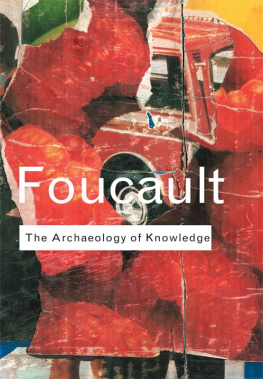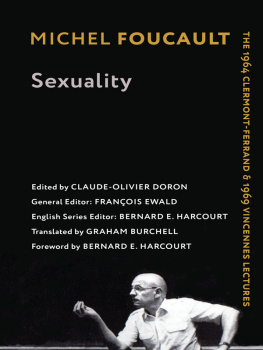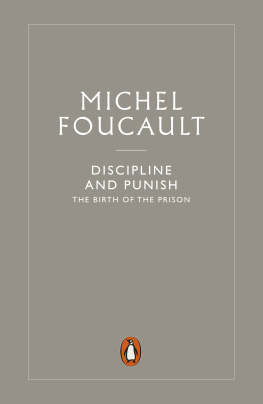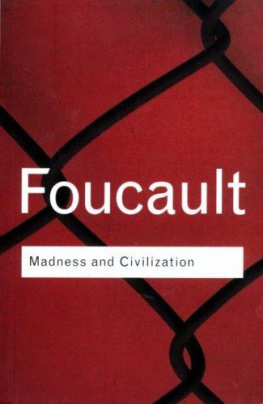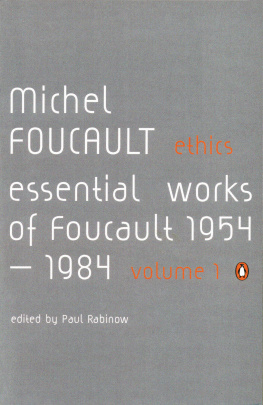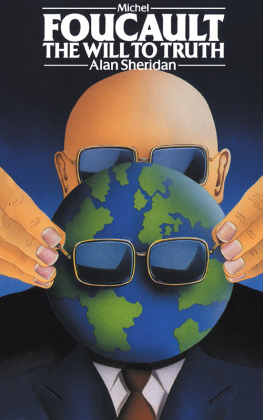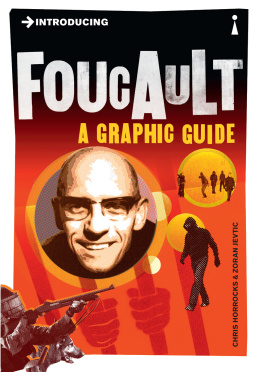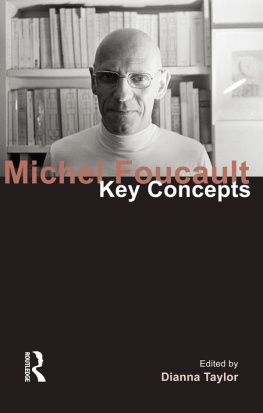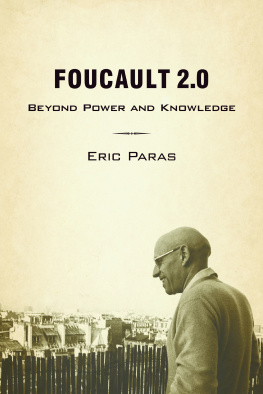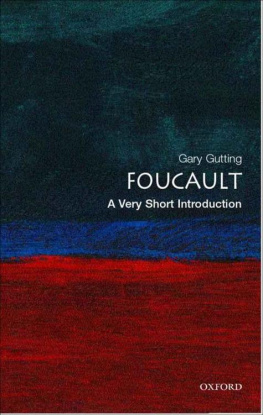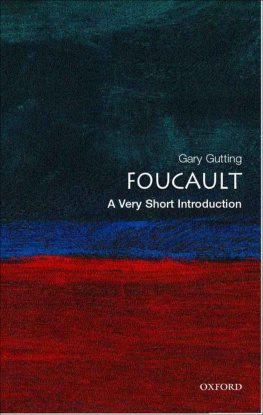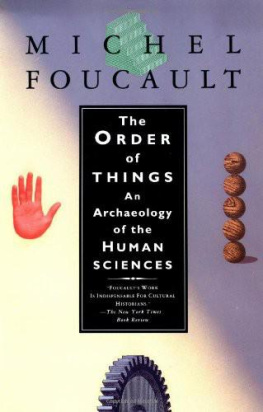Archaeology of Knowledge
Michel Foucault is a very brilliant writer... he has a remarkable angle of vision, a highly disciplined and coherent one,that informs his work to such a high degree as to make the work sui generis original.
Edward W. Said
The Archaeology of Knowledge... provides an unusually sharp outline of [Foucaults] theoretical stance as well as a focused critique of the history of ideas.
Jean Claude Gudon
A necessary guide to Foucaults often difficult ideas... and to his overall historical ambition, which is to define the soil out of which contemporary events in a given period grow.
The Times Literary Supplement
No other thinker in recent history had so dynamically influenced the fields of history, philosophy, literature and literary theory, the social sciences, even medicine.
Lawrence D. Kritzman
Next to Sartres Search for a Method, and in direct opposition to it, Foucaults work is the most noteworthy effort at a theory of history in the last 50 years.
Library Journal
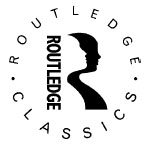
Routledge Classics contains the very best of Routledge publishing over the past century or so, books that have, by popular consent, become established as classics in their field. Drawing on a fantastic heritage of innovative writing published by Routledge and its associated imprints, this series makes available in attractive, affordable form some of the most important works of modern times.
For a complete list of titles visit
www.routledgeclassics.com
Archaeology of Knowledge
Michel
Foucault
Archaeology of Knowledge
Translated by A. M. Sheridan Smith

LArchologie du savoir first published 1969
by Editions Gallimard
English edition first published in the United Kingdom
in 1972 by Tavistock Publications Limited
First published by Routledge in 1989
First published in Routledge Classics 2002
by Routledge
2 Park Square, Milton Park, Abingdon, Oxon OX14 4RN
711 Third Avenue, New York, NY 10017
Routledge is an imprint of the Taylor & Francis Group an informa business
1969 Editions Gallimard
Translation 1972 Tavistock Publications Limited
Typeset in Joanna by RefineCatch Limited, Bungay, Suffolk
All rights reserved. No part of this book may be reprinted or reproduced or utilised in any form or by any electronic, mechanical, or other means, now known or hereafter invented, including photocopying and recording, or in any information storage or retrieval system, without permission in writing from the publishers.
British Library Cataloguing in Publication Data
A catalogue record for this book is available from the British Library
Library of Congress Cataloging in Publication Data
A catalog record for this book has been applied for
ISBN: 10: 0-415-28752-9 (hbk)
ISBN: 10: 0-415-28753-7 (pbk)
ISBN: 13: 978-0-415-28752-4 (hbk)
ISBN: 13: 978-0-415-28753-1 (pbk)
Contents
INTRODUCTION
For many years now historians have preferred to turn their attention to long periods, as if, beneath the shifts and changes of political events, they were trying to reveal the stable, almost indestructible system of checks and balances, the irreversible processes, the constant readjustments, the underlying tendencies that gather force, and are then suddenly reversed after centuries of continuity, the movements of accumulation and slow saturation, the great silent, motionless bases that traditional history has covered with a thick layer of events. The tools that enable historians to carry out this work of analysis are partly inherited and partly of their own making: models of economic growth, quantitative analysis of market movements, accounts of demographic expansion and contraction, the study of climate and its long-term changes, the fixing of sociological constants, the description of technological adjustments and of their spread and continuity. These tools have enabled workers in the historical field to distinguish various sedimentary strata; linear successions, which for so long had been the object of research, have given way to discoveries in depth. From the political mobility at the surface down to the slow movements of material civilization, ever more levels of analysis have been established: each has its own peculiar discontinuities and patterns; and as one descends to the deepest levels, the rhythms become broader. Beneath the rapidlychanging history of governments, wars, and famines, there emerge other, apparently unmoving histories: the history of sea routes, the history of corn or of gold-mining, the history of drought and of irrigation, the history of crop rotation, the history of the balance achieved by the human species between hunger and abundance. The old questions of the traditional analysis (What link should be made between disparate events? How can a causal succession be established between them? What continuity or overall significance do they possess? Is it possible to define a totality, or must one be content with reconstituting connexions?) are now being replaced by questions of another type: which strata should be isolated from others? What types of series should be established? What criteria of periodization should be adopted for each of them? What system of relations (hierarchy, dominance, stratification, univocal determination, circular causality) may be established between them? What series of series may be established? And in what large-scale chronological table may distinct series of events be determined?
At about the same time, in the disciplines that we call the history of ideas, the history of science, the history of philosophy, the history of thought, and the history of literature (we can ignore their specificity for the moment), in those disciplines which, despite their names, evade very largely the work and methods of the historian, attention has been turned, on the contrary, away from vast unities like periods or centuries to the phenomena of rupture, of discontinuity. Beneath the great continuities of thought, beneath the solid, homogeneous manifestations of a single mind or of a collective mentality, beneath the stubborn development of a science striving to exist and to reach completion at the very outset, beneath the persistence of a particular genre, form, discipline, or theoretical activity, one is now trying to detect the incidence of interruptions. Interruptions whose status and nature vary considerably. There are the epistemological acts and thresholds described by Bachelard: they suspend the continuous accumulation of knowledge, interrupt its slow development, and force it to enter a new time, cut it off from its empirical origin and its original motivations, cleanse it of its imaginary complicities; they direct historical analysis away from the search for silent beginnings, and the never-ending tracing-back to the original precursors, towards the search for a new type of rationality To this should be added, of course, literary analysis, which now takes as its unity, not the spirit or sensibility of a period, nor groups, schools, generations, or movements, nor even the personality of the author, in the interplay of his life and his creation, but the particular structure of a given uvre, book, or text.
And the great problem presented by such historical analyses is not how continuities are established, how a single pattern is formed and preserved, how for so many different, successive minds there is a singlehorizon, what mode of action and what substructure is implied by the interplay of transmissions, resumptions, disappearances, and repetitions, how the origin may extend its sway well beyond itself to that conclusion that is never given the problem is no longer one of tradition, of tracing a line, but one of division, of limits; it is no longer one of lasting foundations, but one of transformations that serve as new foundations, the rebuilding of foundations. What one is seeing, then, is the emergence of a whole field of questions, some of which are already familiar, by which this new form of history is trying to develop its own theory: how is one to specify the different concepts that enable us to conceive of discontinuity (threshold, rupture, break, mutation, transformation)? By what criteria is one to isolate the unities with which one is dealing; what is

